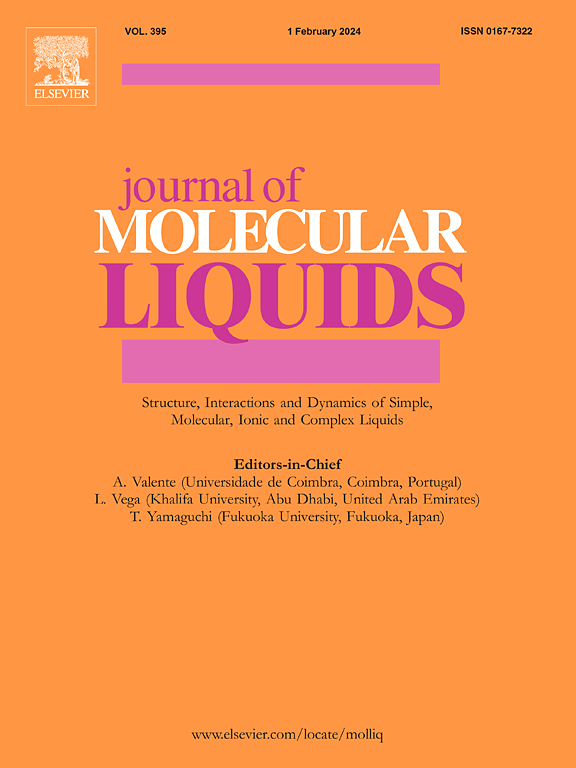Molecular mechanism and process of efficient separation of tert-butanol and water azeotrope using tetraethylammonium chloride-based deep eutectic solvents
IF 5.3
2区 化学
Q2 CHEMISTRY, PHYSICAL
引用次数: 0
Abstract
Tert-butanol (TBA) is a crucial solvent in the chemical and pharmaceutical industries. However, an azeotrope forms with water during its production process, making separation via traditional distillation methods challenging. This study employed the COSMO-Segment Activity Coefficient (COSMO-SAC) model to screen deep eutectic solvents (DESs) for the separation of the TBA-water azeotrope via extractive distillation (ED). Three DESs were selected and prepared: DES1 (tetraethylammonium chloride (TEAC): acetamide (1:2 M ratio)), DES2 (TEAC: ethylene glycol (EG) (1:2 M ratio)), and DES3 (TEAC: imidazole: EG (1:2:1 M ratio)). Vapor-liquid equilibrium (VLE) data for the TBA-water-DES systems were measured at 101.3 kPa. The results indicated that at 20 % (mole fraction) DES, all DESs disrupted the azeotrope, with DES3 proving the most effective. The Non-Random Two-Liquid (NRTL) model accurately fitted the experimental data. Quantum chemical analysis showed stronger interactions between the DES and water compared to TBA, leading to the disruption of the azeotrope. Process optimization of DES3-ED, using total annual cost (TAC) as the objective function, revealed significantly better economic performance compared to the conventional EG-ED process.
使用四乙基氯化铵深共晶溶剂高效分离叔丁醇和水共沸物的分子机理和过程
叔丁醇(TBA)是化工和制药行业的重要溶剂。然而,在其生产过程中会与水形成共沸物,因此通过传统蒸馏方法进行分离具有挑战性。本研究采用 COSMO-分段活性系数(COSMO-SAC)模型筛选深共晶溶剂(DES),以便通过萃取蒸馏(ED)分离 TBA-水共沸物。筛选并制备了三种 DES:DES1(四乙基氯化铵(TEAC):乙酰胺(1:2 M 比例))、DES2(TEAC:乙二醇(EG)(1:2 M 比例))和 DES3(TEAC:咪唑:EG(1:2:1 M 比))。在 101.3 kPa 的压力下测量了 TBA-水-DES 系统的气液平衡 (VLE) 数据。结果表明,当 DES 占 20%(摩尔分数)时,所有 DES 都能破坏共沸物,其中 DES3 效果最好。非随机双液(NRTL)模型准确地拟合了实验数据。量子化学分析表明,与 TBA 相比,DES 与水之间的相互作用更强,从而破坏了共沸物。以年度总成本(TAC)为目标函数,对 DES3-ED 进行了工艺优化,结果显示其经济效益明显优于传统的 EG-ED 工艺。
本文章由计算机程序翻译,如有差异,请以英文原文为准。
求助全文
约1分钟内获得全文
求助全文
来源期刊

Journal of Molecular Liquids
化学-物理:原子、分子和化学物理
CiteScore
10.30
自引率
16.70%
发文量
2597
审稿时长
78 days
期刊介绍:
The journal includes papers in the following areas:
– Simple organic liquids and mixtures
– Ionic liquids
– Surfactant solutions (including micelles and vesicles) and liquid interfaces
– Colloidal solutions and nanoparticles
– Thermotropic and lyotropic liquid crystals
– Ferrofluids
– Water, aqueous solutions and other hydrogen-bonded liquids
– Lubricants, polymer solutions and melts
– Molten metals and salts
– Phase transitions and critical phenomena in liquids and confined fluids
– Self assembly in complex liquids.– Biomolecules in solution
The emphasis is on the molecular (or microscopic) understanding of particular liquids or liquid systems, especially concerning structure, dynamics and intermolecular forces. The experimental techniques used may include:
– Conventional spectroscopy (mid-IR and far-IR, Raman, NMR, etc.)
– Non-linear optics and time resolved spectroscopy (psec, fsec, asec, ISRS, etc.)
– Light scattering (Rayleigh, Brillouin, PCS, etc.)
– Dielectric relaxation
– X-ray and neutron scattering and diffraction.
Experimental studies, computer simulations (MD or MC) and analytical theory will be considered for publication; papers just reporting experimental results that do not contribute to the understanding of the fundamentals of molecular and ionic liquids will not be accepted. Only papers of a non-routine nature and advancing the field will be considered for publication.
 求助内容:
求助内容: 应助结果提醒方式:
应助结果提醒方式:


